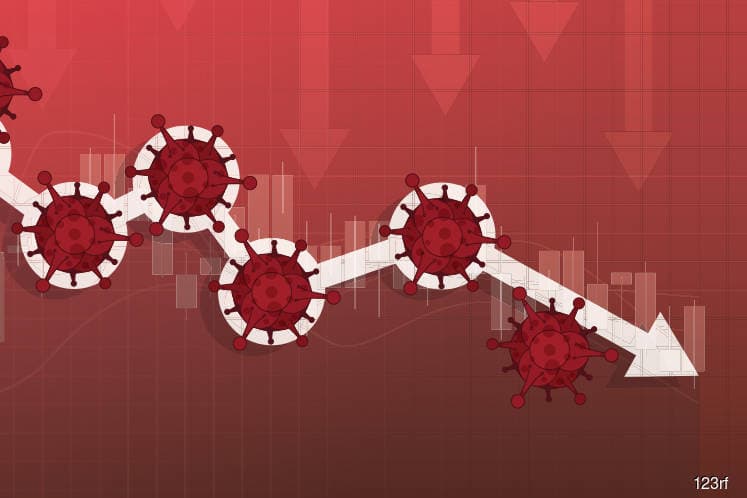
This article first appeared in The Edge Malaysia Weekly on April 20, 2020 - April 26, 2020
With Malaysia seeing sub-100 new daily additions of Covid-19 cases — the lowest since March 14 — in two of the three days in the third phase of the Movement Control Order (MCO3), from April 15 to 28, all eyes will be on whether the positive trend of more recoveries than new patients can continue this week. The Ministry of International Trade and Industry on April 16 expanded the list of essential services allowed to operate during MCO3.
China reported its first economic contraction in 44 years last Friday — first quarter GDP fell 6.8% year on year — and expectations are for the People’s Bank of China (PBoC) to cut its benchmark lending rate for a second time this year on Monday (April 20) to provide further support to the economy.
All 52 participants in a survey by Reuters expect the PBoC to cut its Loan Prime Rate (LPR), with 46 seeing a 20 basis-point cut and six others, a 10bps cut to 3.95% from 4.05% (one-year rate). The overwhelming consensus for a cut follows the central bank’s decision to reduce rates on its one-year medium-term facility by 20bps to a record low of 2.95% on April 15 as well as a 20bps cut in the seven-day reverse repo rate announced on March 30.
Data watchers’ attention will also turn to the impact of the Covid-19 pandemic on Asia’s fourth largest economy. South Korea is set to release its first quarter GDP figures on Thursday. UOB Global Economics expects the economy to record a 2.0% contraction in the first quarter, smaller than the -3.2% forecast for the second quarter, before it stabilises in the second half of the year.
“The pandemic developments form the greatest uncertainty in our growth forecast. Given the contraction projected in 1H2020, we forecast South Korea’s GDP to shrink by 1.0% in 2020, the worst since the Asian financial crisis, when it contracted by 5.1%,” the research house says in an April 17 report.
Back home, key data releases this week include Bank Negara Malaysia’s international reserves as at April 15 on Wednesday. The central bank’s foreign reserves stood at US$101.7 billion on March 31 — sufficient to finance 7.7 months of retained imports and equivalent to 1.1 times short-term external debt — a drop of US$1.7 billion or 1.6% from US$103.4 billion as at end-February.
The Department of Statistics will announce the leading, coincident and lagging indexes for February on Friday. The country’s leading index for January grew 0.1% month on month, from a contraction of 0.3% in December 2019.
The Consumer Price Index for March will be published on Wednesday. February CPI grew 1.3% y-o-y, led by a 2.5% increase in the price of miscellaneous goods and services, a 2.4% rise in transport prices and a 1.6% gain in water, electricity, housing, gas and other fuels.
Singapore — which saw record-high new daily Covid-19 cases last week — is slated to release CPI numbers for March on Thursday, followed by its industrial production data on Friday. Economist consensus is for a CPI increase of 0.4% y-o-y in March, compared with a 0.3% rise in February.
Other economic data from Asian countries that will be made known this week include Taiwan’s March export orders (Monday), South Korea’s first 20-day trade numbers for April (Tuesday), Thailand’s March customs trade data (Tuesday) and Taiwan’s March industrial production (Thursday).
Over in the UK — which last week announced “at least” three weeks’ extension to its lockdown — the unemployment rate for February will be out on Tuesday, with economists expecting a 3.8% y-o-y increase.
On the same day, Germany — which last week said it would start reopening its economy this week after spending one month in partial lockdown — will release its economic sentiment survey. The eurozone’s largest economy will also be announcing its preliminary manufacturing, services and composite Purchasing Managers’ Index (PMI) for April on Thursday.
The UK will also be releasing the same sets of data on the same day. It will release on Wednesday data on its March CPI, which is expected to increase by 1.7% y-o-y, the same rate as in February.
Over at the world’s largest economy, the spotlight will be on the reporting of earnings by large companies as well as the latest weekly initial jobless claims data (for the week ended April 17), to be released by the US’ Department of Labor on Thursday. Some 22 million had reportedly claimed unemployment benefits over the four weeks ended April 11, with the highest weekly number at 6.6 million in the week ended April 4.
On Friday, the US Census Bureau will be releasing its non-defence capital goods order excluding aircraft numbers.
Meanwhile, Statistics New Zealand will be releasing its CPI data for the first quarter on April 19, while Bank of Canada will reveal the country’s core CPI for March on Wednesday.
The world will continue to keep an eye on the efforts to stop the spread of the coronavirus. As at April 17, six countries had recorded more than 100,000 Covid-19 cases: the US, Spain, Italy, France, Germany and the UK.
Save by subscribing to us for your print and/or digital copy.
P/S: The Edge is also available on Apple's AppStore and Androids' Google Play.